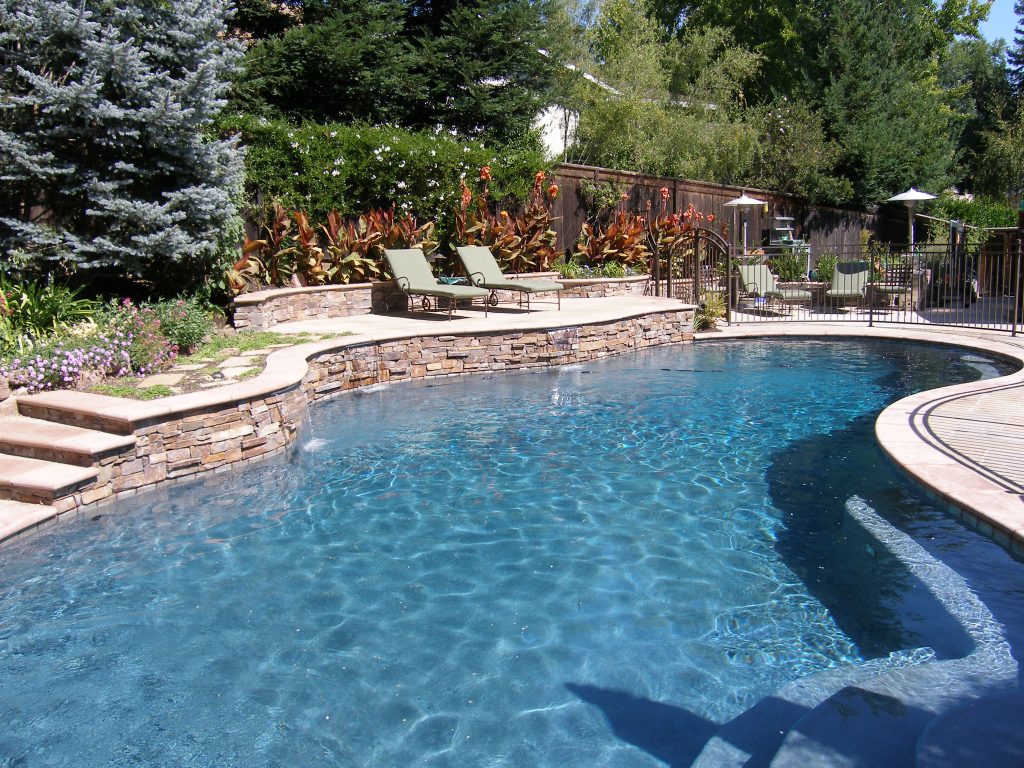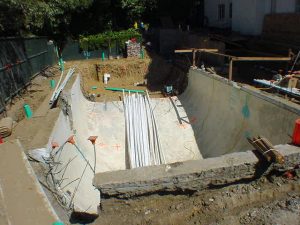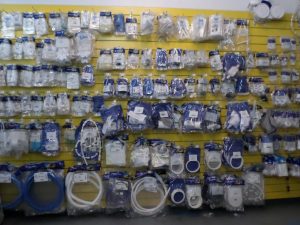
This summer, make the most of your swimming experience by optimizing your pool’s comfort and functionality. Photo: Classic Pools (2017)
When it comes to surviving the summer heat, there’s nothing quite like cooling off in a pool—especially when it’s in your own backyard. Whether you’re thinking about installing a swimming pool or you’re interested in improving your current swimming experience, you can benefit by gaining knowledge about pool building and maintenance. In the following article, we’ll dive into some of the basics with four Diamond Certified Expert Contributors as our guides.
Building a Swimming Pool
Aside from your home itself, a new swimming pool is the largest investment you’re likely to make as a homeowner, which is why Marc Hannigan of Royal Pools of Santa Clara, Inc. advocates careful planning. Step one: Find a good contractor.As the eyes overseeing each phase of the process, a contractor can make or break a pool project, so be sure to hire one who is both capable and trustworthy. Next, consider your pool’s purpose (Exercise? Family fun? Aesthetics?) and any special features you want, as these will influence the design.

Due to the time-intensive process building a pool entails, it’s best to start planning well in advance. Photo: Classic Pools (2017)
Mr. Hannigan says you’ll also need to consider complicating factors such as public utility easements, overhead power lines, heritage trees and challenging soil conditions. Not only can these determine the project’s feasibility, they can also have a substantial impact on its budget, so it’s important to address them before you get into the design phase.
Tim Lindelli of Herb’s Pool Service, Inc. points out a final factor to consider: timing. “Building a new pool is a lengthy process,” he explains. “The permit process alone can take several weeks and potentially hold up the entire project. Add to that allowances for unexpected issues and it’s easy to see just how time-intensive a pool project can be.” If you want to be swimming by summer, Mr. Lindelli recommends getting the ball rolling at the beginning of the year.
Maintaining Your Swimming Pool
If you already have a swimming pool, you don’t need to worry about construction deadlines, but you do have to address maintenance, which is an ongoing responsibility. John Pittman of Roger’s Pool & Spa Service Inc. breaks this down into three aspects, starting with sanitation. “As both a sanitizer and an oxidizer, chlorine offers the most cost-effective means of keeping your pool germ-free,” he says. “When adding chlorine, aim for a chlorine-to-water ratio of between 1.5 and 3 parts per million. This is critical, as adding too much chlorine can cause discomfort for swimmers.” Mr. Pittman says you’ll also need to obtain a proper pH balance (between 7.2 and 7.4) and recommends bringing a water sample to your local pool supply store for testing.
The next aspect is cleaning, which is simple enough if you have a skimmer and an automatic pool cleaner. However, in addition to cleaning the pool itself, Mr. Pittman recommends cleaning your filter once a year, ideally just before the start of swim season. “Clean your filter by disassembling it and using a garden hose to wash off the individual parts,” he explains. “Keep in mind that once you start using your pool again, you’ll need to adjust your filter’s runtime from the offseason minimum to about eight hours a day.”

When it comes to maintaining your pool, a local pool supply store can be an invaluable resource. Photo: Herb’s Pools Service, Inc. (2017)
Mr. Pittman’s third and final aspect of pool maintenance is consistency. Besides staying consistent with cleaning and sanitation, he recommends keeping a constant eye on things. “Examine your pool at least once a week to make sure all systems are functioning properly. Taking a few minutes each week to check on things will go a long way toward preventing major issues.”
Sanitation Alternatives
Despite being the standard for pool sanitation, chlorine has a reputation for creating harsh swimming conditions, with common side effects that include itchy skin and irritated eyes. While these symptoms can sometimes result from an imbalance in pool chemistry, some pool owners prefer to get rid of chlorine altogether in favor of an alternative product.
There are several pool sanitation alternatives in use today, from bromine to ionizers. However, most professionals agree that the best option is salt chlorination, which still uses chlorine, but in a way that diminishes its undesirable effects. Val Toland of Classic Pools explains how it works: “Salt chlorination produces chlorine by electrolysis, which is a process that takes place in a chlorine generator installed at the equipment pad. This generator breaks down the salt and releases chloride molecules into the water, which sanitize the pool before reverting back into salt, at which point the process starts all over again.”
Due to the way the chlorine is produced and dispersed, salt chlorinated pools are known to produce milder, more comfortable swimming conditions than conventionally chlorinated ones. Also, since chlorine is constantly being introduced into the water, it makes for continuous, balanced levels, with no “spiking,” as often occurs when chlorine is added manually. So, if you’re interested in having a more comfortable swimming experience, ask your local pool service company about salt water chlorination.
